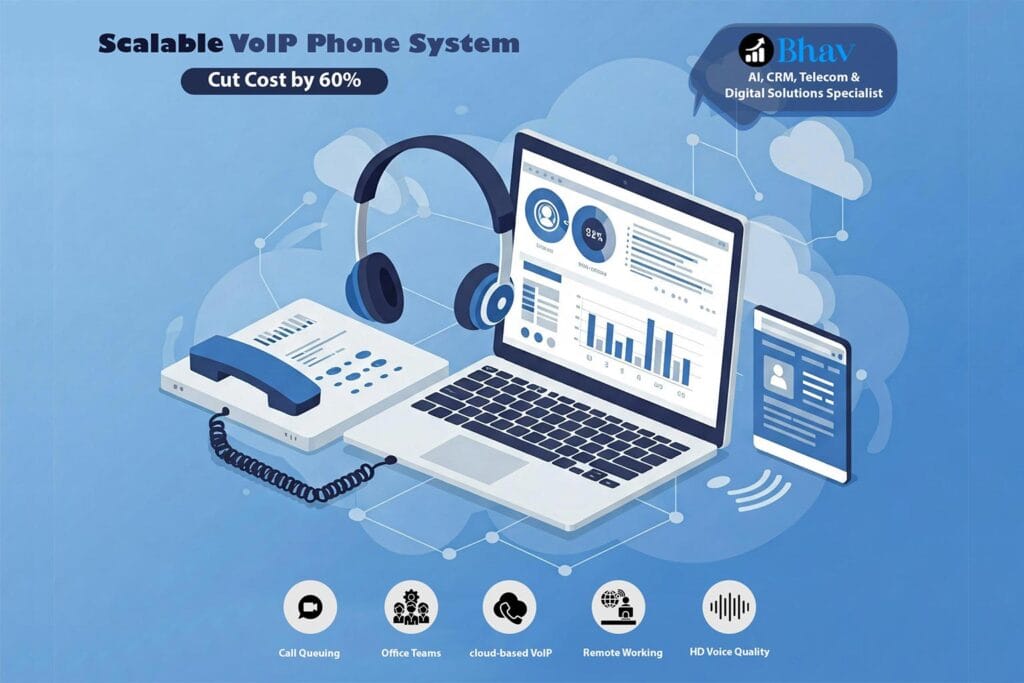
Introduction to VoIP Technology
Voice over Internet Protocol (VoIP) technology has revolutionized the way communication occurs, especially for small businesses. By converting voice signals into digital data and transmitting them over the internet, VoIP allows users to make phone calls using broadband connections instead of traditional telephone lines. This technology not only facilitates voice communication but also enables video calls and other multimedia services, enhancing overall connectivity.
The fundamental differentiation between VoIP and conventional phone systems lies in its reliance on internet connectivity. Traditional systems use dedicated circuits for each call, whereas VoIP calls traverse the internet, allowing multiple calls to be handled simultaneously over the same line, effectively optimizing bandwidth usage. This shift has proven to be cost-effective, attracting small businesses looking to minimize communication expenses while maximizing functionality.
Over the years, VoIP technology has undergone significant evolution. Initially considered a niche solution, its adoption surged with improvements in internet speed and reliability. Advances in codecs and compression technology led to enhanced voice quality, making VoIP an attractive alternative to traditional communication methods. Today, small businesses leverage VoIP systems not only for cost savings but also for the variety of features they offer, such as voicemail-to-email, call forwarding, and automated attendants.
The significance of VoIP in today’s communication landscape cannot be overstated. As remote work and digital collaboration continue to grow, VoIP emerges as a vital tool that integrates seamlessly with other technologies like customer relationship management (CRM) systems and unified communications platforms. For small businesses aiming to compete in an increasingly digital marketplace, adopting VoIP technology can provide them with the necessary tools to enhance customer interactions and streamline internal communications, ensuring they remain agile and efficient in their operations.
Benefits of VoIP for Small Businesses
Voice over Internet Protocol (VoIP) has transformed the communication landscape for small businesses, offering a multitude of benefits that enhance both operational efficiency and cost-effectiveness. One of the most significant advantages of utilizing VoIP technology is the substantial cost savings it provides. Traditional phone lines often entail hefty installation fees and recurring charges, whereas VoIP systems typically require lower initial investments and significantly reduced ongoing expenses. These savings can be pivotal for small businesses operating on tight budgets.
Another key benefit of VoIP is its scalability. As small businesses grow, their communication needs evolve accordingly. VoIP systems facilitate easy adjustments to the number of lines and features without the need for extensive physical infrastructure changes. Companies can easily add or remove lines and users, ensuring that the telecommunication system aligns with their current requirements.
Flexibility is a hallmark feature of VoIP services, allowing employees to communicate from practically anywhere with an internet connection. This adaptability supports remote work scenarios, enabling staff to stay connected whether they are at home, on the road, or in a different office location. This ability to maintain seamless communication contributes to overall productivity and employee satisfaction.
Additionally, VoIP offers enhanced features that can significantly improve the way businesses operate. Functions such as voicemail-to-email, video conferencing, and call forwarding to mobile devices are often included at no extra cost. These advanced capabilities not only streamline communication processes but also enhance collaboration among team members, which is essential for small business growth.
Finally, the improved call quality offered by VoIP technology cannot be overstated. With advancements in internet speeds and VoIP technology, small businesses can enjoy clear, high-definition voice calls, reducing misunderstandings and enhancing customer interactions. For example, a small retail company that adopted VoIP reported a noticeable increase in customer satisfaction due to clearer communications and more reliable service. Such real-world instances highlight the transformative impact VoIP can have on small business operations.
Choosing the Right VoIP Provider
When selecting a Voice over Internet Protocol (VoIP) provider, small businesses must consider several critical criteria to ensure they choose a service that best meets their operational needs. The first aspect to evaluate is the pricing model. Various providers offer different pricing structures, including monthly subscription fees, pay-per-use models, or tiered plans based on feature sets. Understanding the financial implications will aid in finding a provider that fits within your budget while still offering necessary functionalities.
Another important factor is customer support. Effective VoIP service should include responsive customer service options, such as 24/7 availability through phone, chat, or email. Assessing the quality of customer support can often be gauged through user reviews and professional evaluations. Businesses heavily rely on communication tools, making prompt technical assistance vital during downtimes to minimize disruptions.
The feature set offered by the VoIP provider is equally crucial. Modern VoIP solutions should provide features like call forwarding, automated attendants, voicemail-to-email, and conference calling. It is essential to create a checklist of necessary features that align with the operations of the business. Additionally, evaluating system integration with existing software and hardware can determine the overall usability of the VoIP platform.
Reliability is another major criterion; a dependable VoIP provider ensures high uptime rates and effective call quality. Before committing to a service, it is beneficial to investigate the provider’s reputation by examining online reviews, testimonials, and ratings from industry review sites or forums. Lastly, carefully reading the terms of service can illuminate contract details and any hidden fees that could arise. By taking these factors into account, small businesses can make informed decisions regarding their VoIP provider, leading to enhanced communication and efficiency.
Setting Up a VoIP System
Implementing a Voice over Internet Protocol (VoIP) system in a small business can significantly enhance communication efficiency and reduce operational costs. To achieve a successful setup, certain steps need to be followed methodically.
First, it is crucial to assess the existing infrastructure. Evaluate the current network to ensure it can support VoIP services. This includes examining bandwidth capacity and verifying that there are no underlying issues like excessive latency or packet loss. A reliable high-speed Internet connection is essential, as VoIP relies on data transfer to facilitate calls. Conducting a network readiness assessment will help in identifying any areas that may require enhancement.
Next, consider the hardware requirements for your VoIP system. You will need VoIP phones or adaptors for traditional telephones, as well as headsets if employees will be utilizing computers for calls. Additionally, your office may require a robust router capable of prioritizing voice traffic (Quality of Service settings), ensuring calls are clear and uninterrupted.
The installation process generally involves configuring the VoIP provider settings on the phones or adaptors, connecting the devices to the network, and verifying the connection quality. Many providers offer user-friendly dashboards that allow easy management of the telephony system, including call forwarding and voicemail settings. It is advisable to run test calls to confirm that everything is functioning properly before fully transitioning to the new system.
Finally, user training is vital to ensure that staff are comfortable using the new technology. Organizing workshops or providing training materials can significantly ease the adaptation process. Familiarizing employees with the features and functions of the VoIP system will facilitate a smoother transition from traditional telephony.
Integrating VoIP with Other Business Tools
Voice over Internet Protocol (VoIP) technology has revolutionized the way small businesses communicate, offering much more than just a cost-effective solution for telephone services. One of the key advantages of VoIP is its ability to seamlessly integrate with various business tools and software solutions, enhancing operational efficiency and productivity. Integrating VoIP with Customer Relationship Management (CRM) systems, for instance, allows businesses to streamline communication with clients, track interactions, and better manage customer data.
Well-known CRM platforms such as Salesforce and HubSpot offer robust integrations with VoIP systems, allowing businesses to place calls directly from the CRM interface. This integration automatically logs calls, enabling teams to maintain detailed records of communication history. Consequently, employees can focus more on engagement rather than administrative tasks, leading to improved customer service and satisfaction.
Another area where VoIP shines is its compatibility with help desk software. By integrating VoIP with platforms like Zendesk or Freshdesk, businesses can provide better support to their customers through features such as click-to-call, call routing, and call tracking. Such integrations enable support staff to resolve issues more efficiently, thereby enhancing the overall customer experience.
Collaboration platforms, such as Microsoft Teams or Slack, also benefit from VoIP integration. This synergy promotes a more united work environment, allowing team members to initiate voice or video calls, share screens, and collaborate in real-time without switching between applications. This unified communication not only facilitates teamwork but also improves project management, reducing the time spent on coordination.
Incorporating VoIP technology with various business tools brings enhanced connectivity and ease of use, positioning small businesses for sustainable growth and improved operational performance.
Common Challenges and Solutions
Implementing Voice over Internet Protocol (VoIP) can be a transformative step for small businesses, offering enhanced communication capabilities and cost savings. However, the transition is not without its challenges. Small businesses frequently encounter obstacles that can hinder their adoption and effectiveness of VoIP systems. One of the most pressing issues is internet connectivity. A consistent and robust internet connection is vital for VoIP to function optimally. Downtime or poor speeds can lead to dropped calls and frustrating communication experiences. To alleviate these issues, businesses should consider investing in high-bandwidth internet plans and work with reputable service providers to ensure reliable connectivity.
Another challenge that small businesses face is quality of service (QoS) concerns. VoIP systems can suffer from latency, jitter, and packet loss, all of which can degrade call quality. To address QoS issues, implementing Quality of Service configurations on routers can prioritize voice traffic over other types of data. Additionally, regular monitoring of network performance can help identify and mitigate these issues before they significantly impact the user experience.
Security risks are also a major concern for businesses utilizing VoIP technology. Cyber threats such as eavesdropping, unauthorized access, and denial of service attacks can compromise sensitive communications. To bolster security, businesses should employ strong encryption protocols, utilize firewalls, and regularly update their VoIP software to shield against vulnerabilities. Training employees on security best practices is crucial for safeguarding sensitive information.
In conclusion, while small businesses may face challenges when integrating VoIP systems, proactive solutions such as improving internet connectivity, ensuring quality of service, and enhancing security protocols can significantly mitigate these issues. By addressing these common challenges head-on, businesses can reap the benefits of a more efficient and cost-effective communication solution.
Ensuring VoIP Security
As small businesses increasingly adopt Voice over Internet Protocol (VoIP) systems for communication, ensuring the security of these systems has become a paramount concern. VoIP security is vital because these systems are susceptible to various vulnerabilities, just like any other Internet-based technology. One major threat includes phishing attacks, where cybercriminals may impersonate legitimate contacts to extract sensitive information. Additionally, denial-of-service (DoS) attacks can disrupt VoIP services, leading to significant downtime and potential revenue loss.
To mitigate such risks, small businesses should implement several best practices to secure their VoIP systems effectively. First, deploying robust encryption protocols is crucial. Encryption helps protect VoIP traffic by scrambling the data being transmitted, making it unintelligible to potential eavesdroppers. This layer of security is essential for safeguarding sensitive information and maintaining the confidentiality of communications.
Another essential measure is the installation of firewalls specifically configured for VoIP traffic. Firewalls can monitor incoming and outgoing packets, allowing businesses to block malicious traffic before it reaches the VoIP system. Properly configured firewalls can significantly enhance the overall security posture of a small business’s VoIP implementation.
Moreover, regular software updates are critical in maintaining VoIP security. Software developers frequently release patches that address security vulnerabilities, and neglecting these updates can leave systems open to attacks. Small businesses should establish a routine for checking and applying updates to all VoIP-related software and hardware.
Overall, securing a VoIP system involves a proactive approach that addresses potential vulnerabilities. By employing encryption, utilizing firewalls, and consistently updating software, small businesses can bolster their VoIP security, safeguarding their communications and protecting their assets from cyber threats.
Tips for Optimizing VoIP Performance
Ensuring optimal performance for Voice over Internet Protocol (VoIP) services is essential for small businesses seeking reliable communication channels. The first step in enhancing call quality involves evaluating and optimizing the internet connection. A high-speed broadband connection is pivotal; consider both bandwidth and latency as key parameters. Ideally, a dedicated line for VoIP traffic can help maintain consistent call quality. Network congestion can significantly affect communication; therefore, monitoring usage across connected devices and prioritizing VoIP traffic is recommended.
Implementing Quality of Service (QoS) settings on your router can greatly improve VoIP performance. QoS allocates bandwidth to voice calls, ensuring they receive priority over other data types. This minimizes packet loss and jitter, which are detrimental to call clarity. To configure QoS settings effectively, access your router’s administration panel, identify the bandwidth reserved for VoIP, and set it as a high priority. It is important to consult the router’s documentation for specific QoS configuration steps, as these may vary by manufacturer.
Another critical factor in optimizing VoIP performance is the selection of appropriate hardware. Invest in high-quality VoIP phones, headsets, and gateways designed to efficiently handle voice data. Ensure that the devices support advanced features, such as echo cancellation and noise reduction, to enhance the overall call experience. Regular firmware updates for these devices are equally important, as manufacturers often release patches that can improve performance and security.
Finally, consider conducting regular performance tests to identify any potential issues affecting call quality. Various online tools can help measure latency, jitter, and packet loss, enabling small business owners to diagnose and address problems proactively. A diligent approach to monitoring and optimizing VoIP performance can significantly enhance communication effectiveness within small businesses.
Future Trends in VoIP Technology
The landscape of Voice over Internet Protocol (VoIP) technology is continually evolving, particularly for small businesses that seek efficient and cost-effective communication solutions. Emerging trends in this field suggest significant advancements that could reshape how businesses interact with customers and manage internal communications.
One of the most notable trends is the integration of Artificial Intelligence (AI) in customer service functions. AI-driven systems are becoming increasingly sophisticated, allowing for the automation of routine inquiries and providing intelligent routing of calls to the appropriate department. This not only enhances customer experience by reducing wait times but also allows small businesses to allocate resources more effectively. Predictive analytics powered by AI can also provide insights into customer behavior, enabling proactive engagement and personalized service.
Another transformative factor is the rollout of 5G technology. The deployment of 5G networks promises to dramatically increase the speed and reliability of internet connections, which directly benefits VoIP services. With faster data transfer rates, small businesses can expect higher quality voice calls and reduced latency, significantly improving communication clarity. This leap in technology is likely to facilitate more seamless integration of VoIP with other technologies, such as video conferencing and team collaboration tools, thus enabling a holistic communication strategy.
Furthermore, the increasing adoption of cloud-based VoIP solutions is becoming a cornerstone of modern business communication. Cloud VoIP not only reduces the need for extensive infrastructure but also offers scalability that is crucial for small businesses. This flexibility allows organizations to adjust their communication capacity as they grow, ensuring they are equipped to handle varying levels of customer interaction without incurring unnecessary costs.
These trends indicate a promising future for VoIP technology, particularly as small businesses increasingly leverage these advancements to enhance operational efficiency and customer satisfaction. The ongoing developments in AI, the potential of 5G, and the move towards cloud-based solutions are poised to redefine communication norms in the small business sector going forward.



